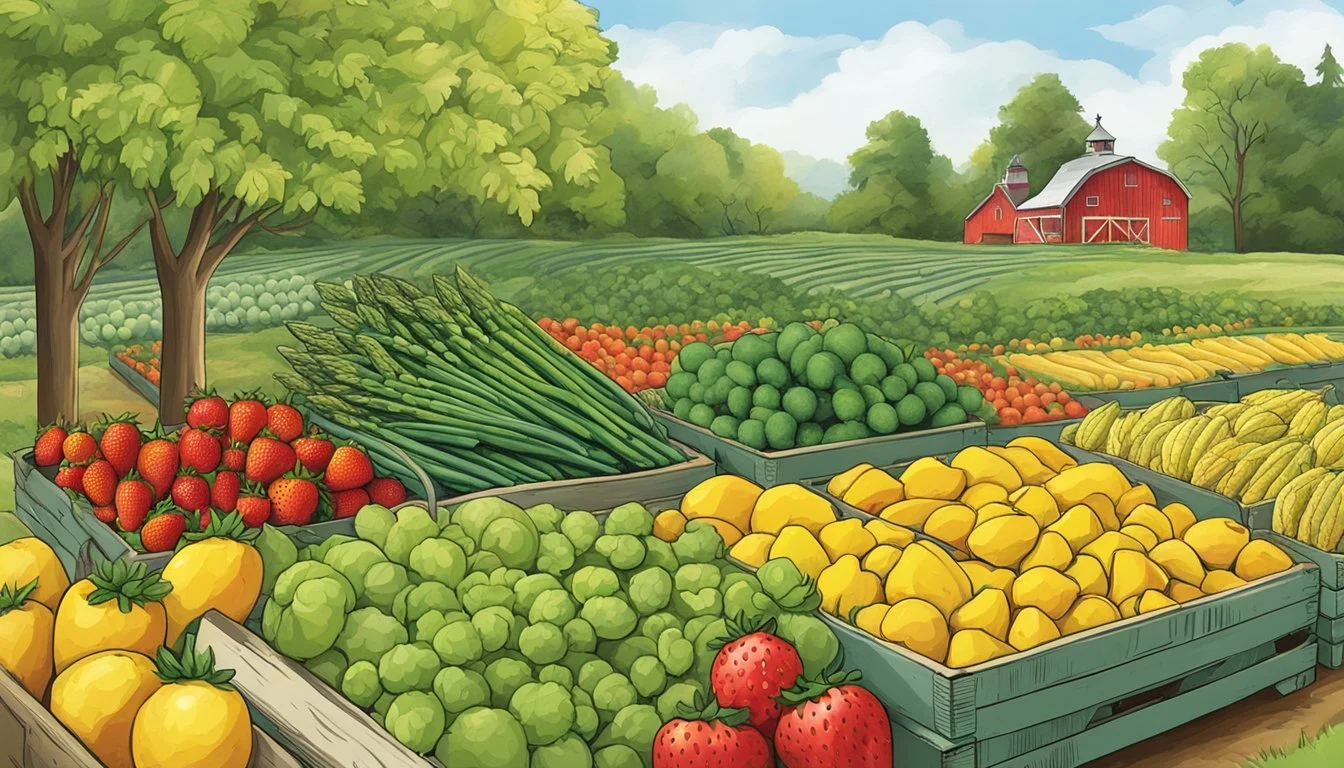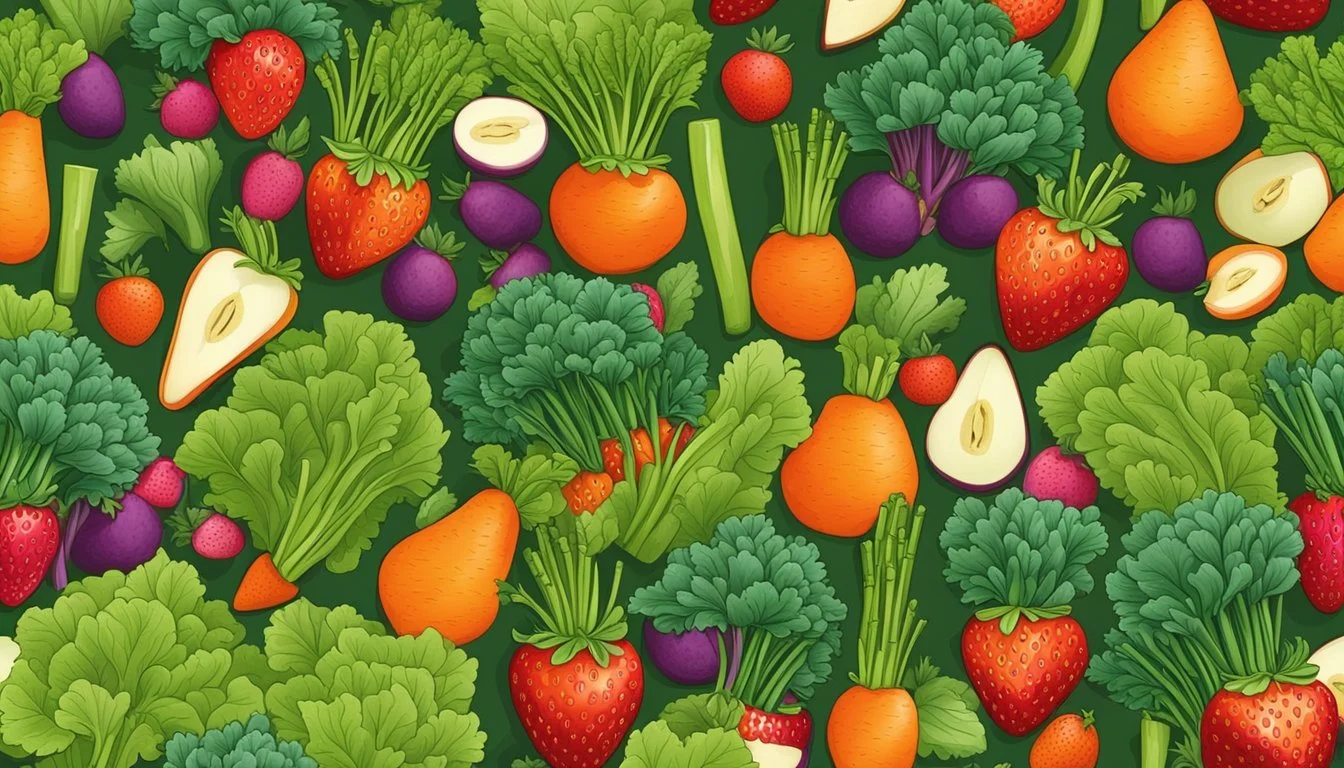Connecticut Seasonal Fruit & Vegetables in April
Your Fresh Produce Guide
This Article is Part of our Connecticut Seasonal Fruit & Veg Calendar
April in Connecticut marks a transitional period for local produce, reflecting a shift in the agricultural cycle. As winter comes to an end, the state's farms begin to offer the first fresh tastes of spring. During this month, a variety of seasonal fruits and vegetables become available, providing freshness and flavor that supermarket imports often lack. Consumers looking for locally-grown options during this time will find that while the selection is still emerging from its winter dormancy, there are several nutritious and tasty choices to be had.
Fiddleheads, the furled fronds of young ferns, make a brief appearance in early spring, offering a unique option for those seeking seasonal greens. While fruit options are limited, April typically sees the last of stored apples still crisp enough to enjoy. Concurrently, farmers prepare for the season ahead with greenhouses starting to yield early crops, and fields being sown with seeds that will flourish in the warmer months.
Connecticut's seasonal vegetables in April often include hardy leafy greens such as kale, (What wine goes well with kale?) which can tolerate the cool nights, and the last of the overwintered root vegetables. These offerings are not only a testament to the state's agricultural adaptability but also a prelude to the diverse harvest that peaks in the summer and fall months. As such, April serves as a month of anticipation for both Connecticut farmers and consumers alike, foreshadowing the abundance soon to come.
Overview of Connecticut's April Produce
April in Connecticut signals the transition into spring, bringing a shift in the availability of fresh seasonal produce. The warming temperatures and longer days contribute to the growth of a variety of fruits and vegetables. During this time, consumers can begin to enjoy the first harvests of the season.
Fruits: In April, while the fruit selection is still emerging, Connecticut often sees the early offerings of:
Strawberries: The sweet, red berries start to come into season, promising the start of a fruitful summer.
Rhubarb: Technically a vegetable but often used as a fruit in desserts, rhubarb is one of the first plants to be harvested in spring.
Vegetables: The vegetable produce during April includes a broadening array of green, leafy vegetables, and hearty roots that have overwintered or are quick to mature:
Spinach: Tender and versatile, it's ideal for both raw and cooked dishes.
Lettuces: Various types become available, providing the base for spring salads.
Kale: Continues from winter and can be found fresh in April.
Radishes: Known for a quick growing cycle, they bring a peppery punch to meals.
Asparagus (how long does asparagus last?): Sought after for its delicate flavor, it marks the essence of spring's arrival.
Additionally, greenhouse technology and cold frames allow for an extended season for some of Connecticut's produce, presenting items such as herbs and microgreens that thrive under these conditions.
Availability can be subject to local climate variances and farmer practice. Consumers looking for the freshest options can turn to farmers' markets and local farm stands, where the produce's journey from farm to table is shortest. As the month progresses, one can expect the variety and volume of available produce to increase, perfectly capturing the essence of spring's bounty in Connecticut.
Vegetables Available in April
April in Connecticut ushers in a variety of vegetables suited to its cool spring climate. During this month, gardens and markets are abundant with fresh produce, offering a range of textures and flavors.
Leafy Greens
In April, leafy greens flourish, with several varieties available for harvest. Residents can enjoy crisp and nutrient-rich selections including:
Arugula: This peppery green makes a great base for spring salads.
Spinach: Known for its versatility, it's ideal for salads, smoothies, and cooked dishes.
Lettuce: Various types of lettuce emerge, perfect for salads and sandwiches.
Root Vegetables
The cool, damp earth of Connecticut in April is also conducive to the growth of root vegetables. These hearty vegetables include:
Onions: Essential for flavoring a multitude of dishes.
Radishes: Offers a crunchy, peppery addition to salads.
Beets: Their sweet, earthy flavor is well-suited for roasting or boiling.
Turnips: Can be enjoyed both raw or cooked, offering a slightly piquant taste.
Other Vegetables
April is not solely about leafy greens and root vegetables; there are other vegetables that Connecticut residents look forward to:
Asparagus: A prized spring vegetable known for its tender stalks and delicate flavor.
Rhubarb: Often used in sweet dishes but is technically a vegetable, it’s ready for harvest in April.
Peas: Sweet green peas begin to appear, signaling the start of the season for podded vegetables.
These vegetables are not only fresh and full of flavor but also represent the start of the growing season in Connecticut, with each offering its own unique benefits to a healthy diet.
Fruit Available in April
In April, the awakening of Connecticut's fruit orchards becomes evident. While it's early in the season for a wide array of fruits, strawberries start to make an appearance towards the end of the month. They are one of the first fruits to herald the start of the fresh produce season in Connecticut.
Look for bright red berries. Strawberries do not ripen after being picked.
Choose berries that are firm, plump, and free of mold.
Pick every ripe strawberry on each plant to help the other berries grow.
Health Benefits:
Strawberries are high in antioxidants.
They are a good source of vitamin C, manganese, folate, and potassium.
The berries are also relatively low in sugar compared to other fruits.
For those eager to enjoy local produce, farmers' markets may begin to have limited quantities of strawberries by late April. However, due to variability in weather patterns, it's always best to check with local farms or markets for the most accurate and current information on fruit availability. As one of the initial fresh, locally grown fruits available, strawberries are often eagerly anticipated by both consumers and growers alike.
Preparing and Cooking Seasonal Produce
April in Connecticut brings a range of seasonal produce that offers fresh and flavorful options for cooking. When dealing with such produce, it's essential to handle them with care to preserve their taste and nutritional value.
Greens like spinach and kale are staples in April. They can be used in a variety of recipes, from fresh salads to hearty sautés. For instance, spinach can be lightly wilted with garlic and olive oil for a simple side dish, or kale can be baked into chips as a healthy snack.
Root vegetables also make an appearance during this month. Turnips and radishes can be roasted to bring out their sweetness or pickled for added tang in salads. Below is a concise table with preparation methods for selected April produce:
Vegetable Preparation Method Spinach Saute with garlic Kale Bake into chips Turnips Roast with herbs Radishes Pickle with vinegar
Herbs such as parsley and chives (how long do chives last?) begin to flourish and can enhance the flavor of many dishes without the need for excess salt. Parsley can be added to tabbouleh, while chives work well as a garnish on soups.
Cooking tip: To maintain the integrity of the vegetables, it's advisable to cook them minimally. Overcooking can lead to loss of nutrients and texture. Steaming or blanching vegetables is an excellent way to preserve their natural taste and health benefits.
Incorporating these seasonal foods into meals not only supports local agriculture but also ensures that one is eating produce at its peak.
Seasonal Eating Advantages
April in Connecticut signals a transition in the local produce available, offering unique benefits for consumers who choose to indulge in seasonal eating. Eating fruits and vegetables in their peak season can enhance flavor, nutrition, and variety in one’s diet.
Fruits and vegetables harvested during their natural growing seasons possess optimal flavor, as they are allowed to ripen fully in the sun. This process increases the natural sweetness and juiciness, providing a superior taste experience compared to produce harvested out of season.
The nutritional value of produce also peaks when it is harvested in the appropriate season. These items contain more natural vitamins and antioxidants at this time, offering greater health benefits with each bite.
Cost-effective: Seasonal produce is often more abundant and less expensive.
Environmental sustainability: Local, in-season produce typically requires fewer resources for transportation and storage, reducing the carbon footprint.
Month Seasonal Produce April Asparagus Rhubarb Cress
These plants are cultivated without the need for long-distance shipping or energy-intensive storage, contributing to eco-friendliness and support for local farmers.
Eating with the seasons, individuals experience a rotating selection of produce, enhancing the diversity of their meals. This variation ensures a broader intake of nutrients and fosters creativity in the kitchen.
Incorporating seasonal produce into one's diet during April and beyond can significantly benefit taste, nutritional content, and environmental impact, highlighting the multifaceted advantages of seasonal eating.
Where to Find Seasonal Produce
Connecticut offers a variety of locations for residents and visitors to purchase fresh, seasonal produce in April. The harvest times influence the availability of fruits and vegetables in local markets, ensuring that consumers have access to the freshest options.
Farmers Markets
Farmers markets in Connecticut are a hub for local, seasonal produce directly from growers. In April, shoppers will find early spring vegetables and the last of cold-storage winter crops. They are routinely held weekly in multiple locations across the state, creating opportunities to buy fresh produce and support local agriculture.
Grocery Stores
Local grocery stores frequently stock seasonal produce sourced from within the state. While they might offer a broader range of fruits and vegetables, some specifically highlight Connecticut-grown produce to cater to consumers looking for local options. One can often find seasonal harvest times reflected in the availability and variety of produce in these stores.
Farm Stands
Farm stands provide a direct-from-the-source shopping experience, often located on the premises of the farms where the produce is grown. They not only sell freshly harvested produce but also offer a connection to the farm itself. Local farm stands become more prevalent as the weather warms and are an excellent venue for finding April's seasonal offerings in Connecticut.
Understanding Harvest Times
In Connecticut, the progression of the seasons significantly influences the harvest times of fruits and vegetables. Each season offers a unique palette of produce, dependent on specific weather patterns and daylight hours that promote the growth of certain crops.
Spring heralds the arrival of early harvests with a limited selection as the last frosts recede. Gardeners and farmers eagerly anticipate the ground thawing to plant and nurture the initial offerings of the year. During this time, leafy greens and some root vegetables can be typically first harvested.
Summer provides the optimal warm weather and longer daylight hours essential for the majority of fruit and vegetable cultivation. This season gives way to a vast array of produce, reaching their peak harvest times. Berries, stone fruits, and a variety of vegetables are among the bounty available during summer's zenith.
Fall brings a cooler climate that favors the harvesting of hardier produce. This season is known for its apples and pumpkins, along with a resurgence of certain crops that thrive in cooler temperatures, such as kale and Brussels sprouts. Fall's harvest continues until the first frost sets in.
Winter is a dormant period for most outdoor farming in Connecticut. Nonetheless, some cold-tolerant greens and stored root vegetables from fall harvests remain available.
Below is a concise representation of typical harvest times in Connecticut:
Season Fruits Vegetables Spring Strawberries Lettuce, Asparagus Summer Blueberries, Peaches Tomatoes, Cucumbers Fall Apples, Pears Pumpkins, Squashes Winter - Stored root vegetables
These timings, while generally consistent, can vary dependent on the annual climate variations and specific regional conditions.
Health Benefits of Seasonal Eating
Eating fruits and vegetables in their peak season provides numerous health benefits. They often contain more nutrients when harvested at the right time, which can promote better overall health.
Freshness: Seasonal produce is typically fresher, having been harvested at its peak and sold shortly afterward. Fresh fruits and vegetables have a higher nutritional value when they are consumed soon after harvest.
Nutritional Value:
Seasonal produce tends to have a higher concentration of vitamins, minerals, and antioxidants.
The longer fruits and vegetables are stored, the more nutrients they can lose.
Here is a brief overview of health benefits associated with eating seasonally:
Immune support: Seasonal produce can help bolster the immune system.
Skin and eye health: Fruits and vegetables contain vitamins that contribute to the health of the skin and eyes.
Cancer and diabetes prevention: A diet rich in a variety of plant foods can reduce the risk of certain chronic diseases.
Nutrients Benefits Vitamins Supports immune function Antioxidants Protects against cell damage Fiber Aids in digestion and satiety Phytochemicals May reduce disease risk
Incorporating seasonal fruits and vegetables from Connecticut into one's diet in April, such as leafy greens and spring herbs, can contribute positively to one's health through these mechanisms. The body can utilize the full spectrum of nutrients available in these foods which supports various bodily functions and disease prevention pathways.









